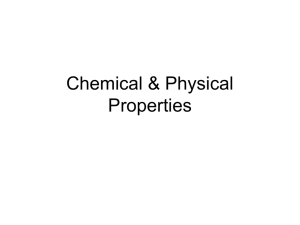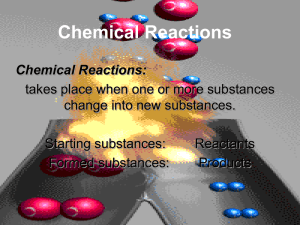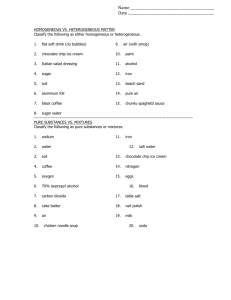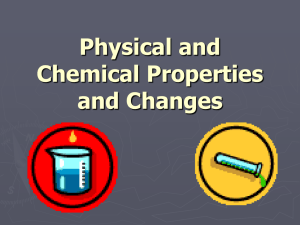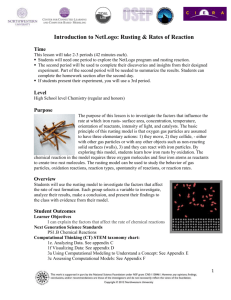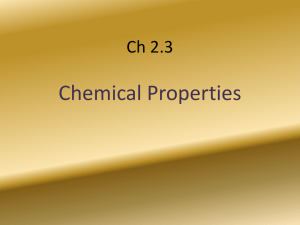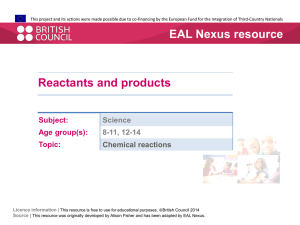Matter-Properties and Changes
advertisement
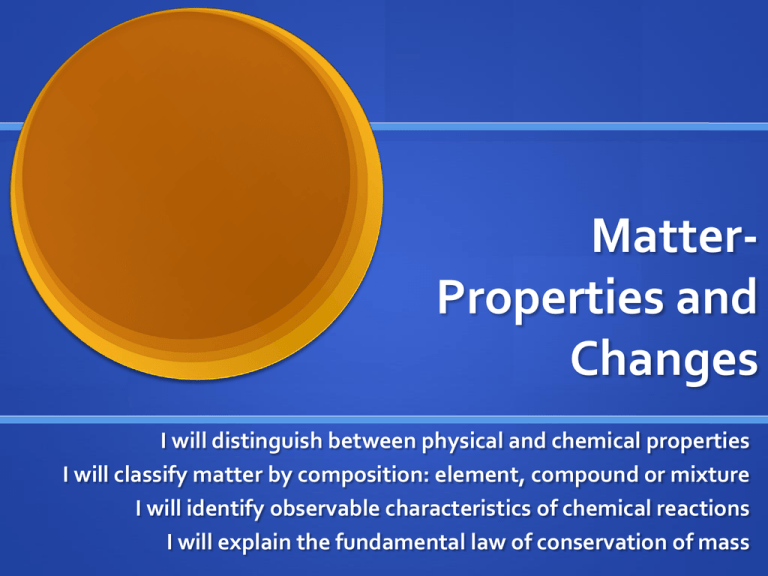
MatterProperties and Changes I will distinguish between physical and chemical properties I will classify matter by composition: element, compound or mixture I will identify observable characteristics of chemical reactions I will explain the fundamental law of conservation of mass Properties of Matter I will identify the characteristics of a substance I will distinguish between physical and chemical properties I will differentiate among the physical states of matter Substances Matter that has a uniform and unchanging composition Aka pure substance Example 1 Table Salt Always 100% sodium chloride Example 2 Water H2O NOT AN EXAMPLE Sea water Samples vary by location Amount of salts, water, dissolved substances Physical Properties A characteristic that can be observed or measured WITHOUT changing the sample’s composition Density Color Odor Taste Hardness Melting point Boiling point Examples-Physical Properties Salt (sodium chloride) Forms solid white crystals at room temperature Unique salty taste Oxygen Colorless Gas at 25 degrees Celsius Melting point -218 degrees Celsius Boiling point -183 degrees Celsius Density 0.0014 g/cc Extensive Properties Dependent upon the amount of substance present Examples Mass Volume Length Weight Intensive Properties Independent of the amount of the substance present Examples Chemical Properties The ability of a substance to combine with or change into one or more other substances And/Or The inability of a substance to change into another substance Example Iron forms rust when combined with air Iron + Nitrogen (at room temperature) = no chemical change Observing Properties of Matter Every substance has its own unique set of physical and chemical properties May vary depending on conditions of immediate environment Room temperature, standard pressure, etc. Example Copper Physical Properties Chemical Properties Reddish brown Shiny Malleable (easily shaped) Ductile (drawn into wire) Conducts heat/electricity Density 8.92 g/cc Melting Point 1085 ℃ Boiling Point 2570 ℃ Forms green copper carbonate compound when in contact w/ moist air Forms new substances when combined with nitric and sulfuric acids Forms a deep blue solution when in contact with ammonia States of matter Solid Liquid Gas Plasma FUN FACT: (only occurs naturally on Earth in the form of lightening bolts!) PHYSICAL PROPERTY!!!!! Solids A form of matter that has its own definite shape and volume. Will only expand SLIGHTLY when heated Examples Wood Iron Does NOT conform to shape of container Paper Sugar Particles are VERY tightly packed Incompressible Volume stays the same Example Wax (moldable) but volume doesn’t change Liquids A form of matter that flows, has constant volume, and takes the shape of its container Examples Water Blood Mercury Virtually incompressible Tend to expand when heated Liquid Particles NOT rigidly held in place less closely packed than solids Are able to move past each other Gases A form of matter that flows to CONFORM to the shape of its container and fills the ENTIRE volume of its container Examples Neon Lighted signs Methane Cooking Air Mixture of gases Particles are VERY far apart EASILY compressed A substance NATURALLY in the gaseous state at room temperature RELATED TERMS Vapor The gaseous state of a substance that is a SOLID or LIQUID at room temperature Example steam Quick Think Describe the characteristics that identify a sample of matter as being a substance. Using what you know about the compressibility of gases, explain why the oxygen in a SCUBA tank is compressed. Classify each of the following as a physical or chemical property Iron and oxygen form rust Iron is more dense than aluminum Magnesium burns brightly when ignited Oil and water do not mix Mercury melts at -39 ℃ Create a table that describes the three common states of matter in terms of their shape, volume, and compressibility. Quick Think- Check The sample of matter must have a uniform and unchanging composition to be a substance. Properties Chemical (rust) Physical (density) Chemical (burning) Physical (mixing) Physical (melting) point) Particles of gas are spaced apart and are easily compressed. Therefore, it is possible to put a significant volume of oxygen in the tank, which allows the diver to remain under water longer! Solid Liquid Gas Definite volume Definite volume Fills volume of container Definite shape Fills container shape Takes shape of container Incompressible Virtually incompressible Compressible Changes in Matter I will define physical change and list several common physical changes I will define chemical change and list several indications that a chemical change has taken place I will apply the law of conservation of mass to chemical reactions Physical CHANGES Alter a substance WITHOUT changing its composition Might result in dramatically different appearance (yet leave the composition of the substance unchanged) Examples Crunching up a piece of aluminum foil Cutting a sheet of paper Breaking a crystal Phase changes (solid, liquid, gas) Key words of Physical Changes Bend Grind Crumple Split Crush Chemical CHANGES A process that involves one or more substances changing into a NEW substance New substance Formed in reaction Different compositions — than original substance(s) Different properties — than original substance(s) Example Fermentation of juice, sugars, and other ingredients (making wine) Rusting of iron (a chemical combo of iron and oxygen) Chemical CHANGES Commonly referred to as a chemical reaction Reactants Starting substances Products New substances Example Reactants = Iron, Oxygen Product = rust Key Words of Chemical Changes Explode Rust Oxidize Corrode Tarnish Ferment Burn Rot The LAW of Conservation of Mass Mass is neither created nor destroyed during a chemical reaction Mass is conserved Mass of Reactants = Mass of Products Conservation of Mass Problem Known Mass mercury (II) oxide = 10.0g Mass liquid mercury = 9.26g Mass Reactants = Mass Products Mercury (II) oxide = Mercury + Oxygen Unknown Mass formed oxygen = ? g 10.0g = 9.26g + ? 0.740 g of Oxygen formed Quick Think Describe the results of a physical change and 3 examples. Repeat with chemical change. A friend tells you, “because composition does not change during a physical change, the appearance of a substance does not change.” Is your friend correct? Explain WHY? Solve each of the following In the complete reaction of 22.99 g of sodium with 35.35 g chlorine, what is the mass of the sodium chloride formed? A 12.2 g sample of X reacts with a sample of Y to form 78.9 g XY. What way the mass of Y that reacted? Quick Think-Check During a physical change a substance is altered but its composition does not change. EX melting, freezing, boiling, bending, tearing During a chemical change the composition of a substance IS altered. EX color change, odor, temperatures change, formation of gas or solid from a liquid. The statement is false. Composition doesn’t change but a change in appearance often accompanies a physical change. 58.44g of sodium chloride 66.7 g of Y

